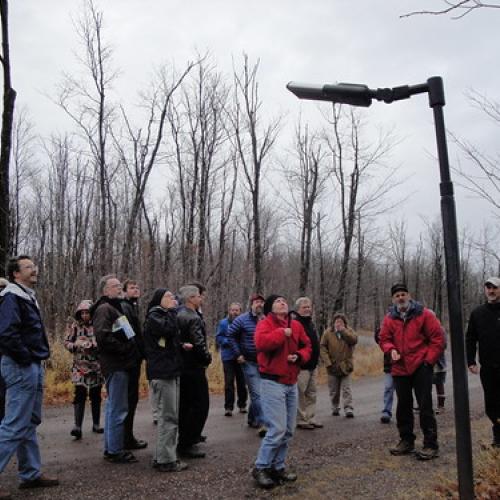Over 25 attendees joined Northeast Clean Energy Resource Teams (NE CERT) on a cold and blustery October 25th to learn about renewable energy, energy efficiency, and local food projects on the North Shore. The tour included visits at the Finland Community Center, the Finland Fire Hall, Wolf Ridge Environmental Learning Center, and Victus Farm of Silver Bay’s Eco-Industrial Park.
Meeting attendees learned from inspiring clean energy leaders in their community about local projects featuring solar electric, solar thermal water, geothermal, biomass, wind, lighting, energy efficiency improvements, as well as a self-contained food and energy generating ecosystem.
The Finland Community Center is a brand new, multi-use facility for community events and rental in the Northern Lake County area. The building features the Crystal Bay Township office, a commercial kitchen, meeting rooms, gym/multipurpose room with a stage, trail head facilities with outside accessible bathrooms, ball field, tennis court, and more in the works.
David Abazs, Chair of Crystal Bay Township and Honor Schauland, Friends of Finland Community, described how valuable the new center is to the community. The project was a result of nearly 10 years in the making. Discussions about this new facility sparked a broader conversation in Finland about how to build community. In a town with a population of about 360, one meeting on the facility garnered attention and support from 50 residents. It turned out that the process of creating the new Center was as valuable, if not more so, than the center itself, and now, Finland has an incredible asset to show for it. Indeed, the Center has become a true community center and is used nearly every night of the week for everything from movie night to adult volleyball.
The building construction is a key part of the facility being a user-friendly and environmentally-friendly space. Simple and warm design welcomes all and room dividers make spaces scalable to their intended uses. Walls constructed with double studs instead of single studs allow for a very thick air space into which cellulose insulation was blown. Ample daylight pours into the building through numerous triple-pane windows, helping to save energy costs for both lighting and heating.
The Finland Community Center is 100% geothermal-heated by circulating water through tubing in an underground field (approximately 10 feet below ground surface and the size of a swimming pool) and in the concrete floor of the facility which is protected from heat transfer with the ground beneath the building by 6 inches of foam insulation. The geothermal equipment inside the building requires only approximately a 5 feet by 10 feet space for two units. The electricity requirement of the building’s geothermal heating system and lighting will be partially offset with several solar photo voltaic (PV) panel arrays.
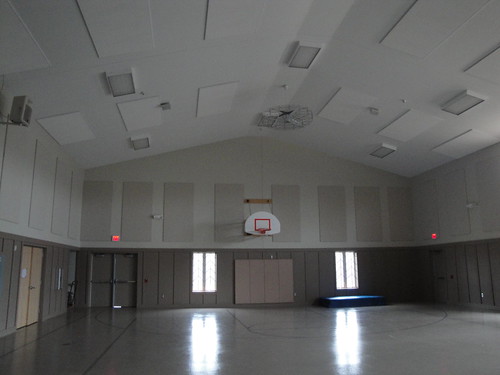 Three pole-mounted panel arrays are installed on the south side of the building and will provide 10.5 kilowatts of energy, which is approximately 46 kilowatt-hours per day. Many of the materials on the solar PV arrays were sourced or assembled in Minnesota, including the 18-ft steel pole from Northshore Steel in Two Harbors, MN and the fourteen “USA-made” 250-watt PV panels on each pole. These pole-mounted arrays have the ability to adjust to appropriate angles for our winter and summer seasons.
Three pole-mounted panel arrays are installed on the south side of the building and will provide 10.5 kilowatts of energy, which is approximately 46 kilowatt-hours per day. Many of the materials on the solar PV arrays were sourced or assembled in Minnesota, including the 18-ft steel pole from Northshore Steel in Two Harbors, MN and the fourteen “USA-made” 250-watt PV panels on each pole. These pole-mounted arrays have the ability to adjust to appropriate angles for our winter and summer seasons.
The locations for footings are identified for two additional ground-mounted fixed-angle 2.66 kW panel arrays at the Finland Community Center and the Finland Fire Hall. The panels for these two ground-mounted arrays are from Silicon Energy in Mt. Iron, MN. David described these panels, with a life expectancy of 50-100 years, as being superior in quality to other panels on the market. The panels are made for the Minnesota climate by having no drip-edge so that snow can melt off of the panels freely. The panels at the Finland Fire Hall will be highly-visible to the community and offset some of the electrical energy to the Fire Hall building. Dave Abazs reported that while you probably wouldn’t know it, nearly 10% of residents in the Finland area live with solar systems.
To learn more about the Finland Community center’s efforts click here.
Wolf Ridge Environmental Learning Center is a nationally-respected and accredited K-12 school and residential learning center. Wolf Ridge’s educational activities immerse participants in nature exploration, cultural history, outdoor skills, team-building, and personal growth. 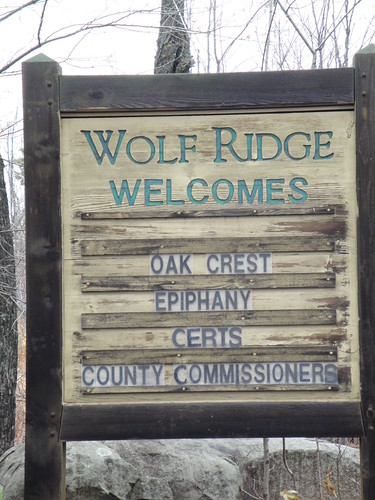 In addition to K-12 school programs, Wolf Ridge offers summer camps, family vacations, grandparent/grandchild Road Scholar, wilderness trips, graduate naturalist training, and live education animal programs.
In addition to K-12 school programs, Wolf Ridge offers summer camps, family vacations, grandparent/grandchild Road Scholar, wilderness trips, graduate naturalist training, and live education animal programs.
Pete Smerud – Wolf Ridge’s Executive Director, Peter Harris – Science Project Coordinator (integral to implementation of sustainability into the sciences and the campus operations), and Pete Gravett – Program Director, explained what a magical place Wolf Ridge is for students of all ages to learn about and experiment with clean energy solutions. Wolf Ridge has accomplished many “wins” for the environment over its 40+ years of developing a knowledgeable and committed citizenry to work together for a quality environment. The visit to Wolf Ridge this time was focused on the following initiatives: biomass heating system, solar water heating, clean energy education, and energy efficiency through LED lighting, building envelope improvements and hot water heating system piping upgrade.
Wolf Ridge heats water in a centralized boiler and then delivers that hot water via piping to all buildings on campus. Pete shared that the underground piping pathway could easily be seen in winter; the heat loss from the piping was so great that the snow above the piping pathway sat several inches lower than snow elsewhere on the Ridge. Before Wolf Ridge invested in upgrading its biomass heating system from being fueled by cord-wood to wood pellets, the hot water distribution (and cold water return) network was upgraded to Uponor Ecoflex Pre-insulated Pipe. The piping upgrade alone resulted in a 20% reduction in fuel supply.
The boiler equipment was upgraded to include two WoodMaster commercial boilers that burn wood pellets delivered from Great Lakes Renewable Energy, Inc. in Hayward, WI.  Wolf Ridge intentionally remained with a biomass-fueled boiler system with a long-term vision to support local businesses and use local fuel. Wood pellets are a more fuel efficient alternative to cord-wood due to the low moisture content (only 4%) and how completely the pellets burn. On cord wood fuel, Wolf Ridge would generate at least a drum-full of ash per week. On pellets, a drum-full may be generated over an entire month.
Wolf Ridge intentionally remained with a biomass-fueled boiler system with a long-term vision to support local businesses and use local fuel. Wood pellets are a more fuel efficient alternative to cord-wood due to the low moisture content (only 4%) and how completely the pellets burn. On cord wood fuel, Wolf Ridge would generate at least a drum-full of ash per week. On pellets, a drum-full may be generated over an entire month.
The buildings at Wolf Ridge were built in the 1980s when energy-efficient building techniques were not common place. An energy audit of the buildings on campus revealed that building doors were one of the greatest sources of heat loss due to hanging poorly on the frames and having little to no insulation value any more. Curries Trio-E doors, with injected foam for energy efficiency and a steel-stiffened core for durability, were installed on campus buildings.
Lighting for campus walkways has been converted from each unit having 75 watts of halogen lights to 40 watts of LED lights. 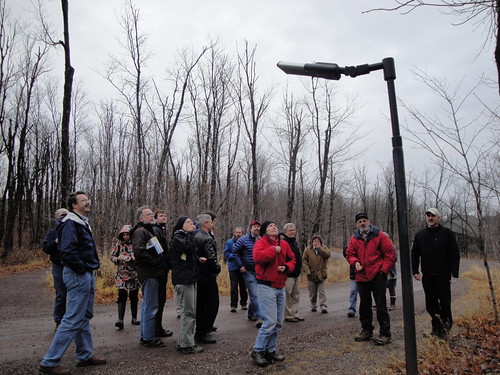 These BetaLED light fixtures are dark sky-friendly, meaning they minimize upward lighting and night sky light pollution. Motion sensors can be added to the units in the future so that the lighting can be dimmed to 50% most of the time and brighten when someone approaches the fixture.
These BetaLED light fixtures are dark sky-friendly, meaning they minimize upward lighting and night sky light pollution. Motion sensors can be added to the units in the future so that the lighting can be dimmed to 50% most of the time and brighten when someone approaches the fixture.
Half of the hot water for the 180-person dormitory at Wolf Ridge is supplied by solar water heating. The solar water heating unit is mounted at the doorway of the dormitory to facilitate education about clean energy.
To view a video concerning Wolf Ridge’s environmental and energy education efforts click here.
Lastly, the tour visited the Science Center where the entire front yard has renewable energy technologies showcased for students’ interactive learning. Technologies include a windmill, a sun-tracking solar PV array, a solar oven, a battery-operated lawn-mower rechargeable with solar panels, and the “death ray,” a gift to Wolf Ridge from CERTs to demonstrate how powerful the sun’s heat can be when concentrated. Indoors, students can view the energy meters for the wind and solar energy technologies in the front yard and monitor the entire building’s energy use shown on a screen. Access to such information has spurred “energy hog” contests where students go wild turning everything on in the building (drawing as high as 12 kilowatts at one time) and “how low can you go” contests (turning as much off as possible and using as low as 1 kilowatt).
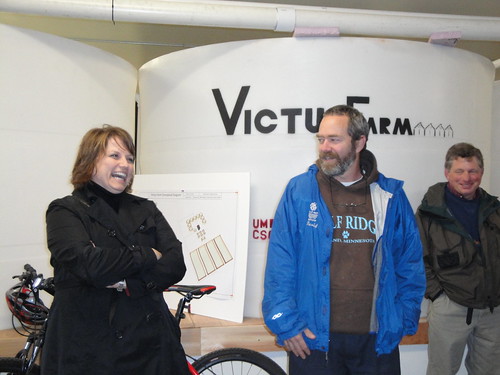 Victus Farm is a self-contained food and energy generating ecosystem. It is a project that developed from a partnership between UMD’s Center for Sustainable Community Development (CSCD) and the City of Silver Bay. This project was also made possible, in part, through Minnesota Pollution Control Agency and Iron Range Resources and Rehabilitation Board Grants and funding through the Minnesota Legislature.
Victus Farm is a self-contained food and energy generating ecosystem. It is a project that developed from a partnership between UMD’s Center for Sustainable Community Development (CSCD) and the City of Silver Bay. This project was also made possible, in part, through Minnesota Pollution Control Agency and Iron Range Resources and Rehabilitation Board Grants and funding through the Minnesota Legislature.
Victus Farm is a proof-of-concept project to test whether it is economically viable to create jobs while producing local, healthy food and clean energy. The integrated fish, plant and algal production system is input-output driven with the intent of building the smallest physical system footprint that is carbon neutral and optimizes food output. 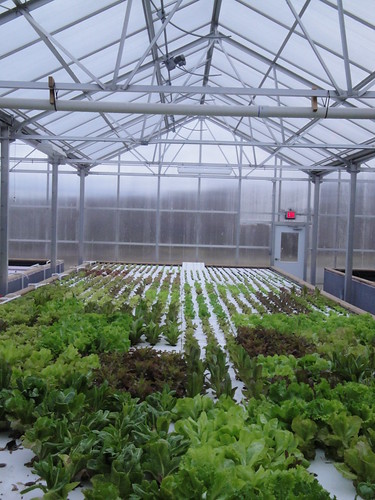
The deep tanks holding tilapia in the fish production area was designed with optimization in mind, too. Tilapia will take advantage of the full water column, whereas other species spend most of their time in the upper two to three feet. The tilapia, weighing only 5 grams each at present, will need another nine months to reach an average of 900 grams, an ideal weight for consumption. The fish species was also selected to keep the North Shore’s ecosystem intact. Tilapia cannot naturalize or survive in northern Minnesota’s environment and therefore won’t result in an invasive fish species problem in the future.
The facility is the first organic aquaponic farm in the Midwest, growing more than 430 heads of lettuce per week and a variety of herbs. Three of the four water troughs are being used for production in the greenhouse portion of the facility. The fourth trough will be used in the future to grow algae, which will become an in-house source of food for the fish when mixed with locally-produced grains. The water troughs in production contain floating foam boards with holes, in which plants thrive in small mesh cups filled with growing medium.
The troughs in the greenhouse are double-layered tanks, with the bottom tank available for rainwater storage. All water in the system was supplied by and is restored with rainwater collected at the facility. 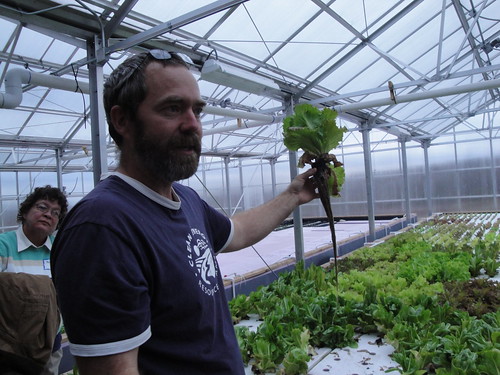 Rainwater is treated prior to use by removing particulates, filtering through carbon, and disinfecting with ultraviolet light. The stored rainwater also serves as a thermal mass in the greenhouse.
Rainwater is treated prior to use by removing particulates, filtering through carbon, and disinfecting with ultraviolet light. The stored rainwater also serves as a thermal mass in the greenhouse.
The facility will use energy generated at a 20 kilowatt wind turbine (install planned for spring) located near Silver Bay. It takes 89 minutes for a single drop of water to travel through the entire system at the facility. The fish add valuable nutrients to the water prior to it flowing through the plant troughs where plant roots uptake these nutrients and filter the water before it is pumped high enough to allow it to gravity-flow through the fish tanks and troughs again.
Please click here to read more about the Silver Bay project!

